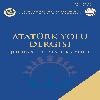PATRİK II. FOTİOS DÖNEMİNDE İSTANBUL RUM/ORTODOKS PATRİKHANESİ VE HRİSTİYAN BİRLİĞİNE YÖNELİK FAALİYETLER (1929-1935)
İSTANBUL RUM/ORTHODOX PATRİARCHATE DURING THE REIGN OF PATRIARCH PHOTIOS THE 2ND AND ACTIVITIES FOR THE CHRISTIAN UNION (1929-1935)
___
- T.C. Cumhurbaşkanlığı Devlet Arşivleri Başkanlığı Cumhuriyet Arşivi (BCA)
- T.C. Dışişleri Bakanlığı Türk Diplomatik Arşivi
- Resmi Gazete
- Areti, Halmouki. “İ Prokatarktiki Diorthodoksi Epitropi Tou Etous 1930 Stin İera Moni Vatopediou. Ta Tethenta Zitimata Kaı İ Protathises Liseis (İstorikokanoniki Theorisi)” (1930 Yılında Vatopedi Kutsal Manastırındaki Panortodoks Ön Komite. Sorunlar ve Önerilen Çözümler), Lisans Tezi. Selanik: Aristotelios Üniversitesi, 2006.
- Atatürk’ün Söylev ve Demeçleri. Ankara: Atatürk Araştırma Merkezi Yayınları, 2006.
- Baş, Mustafa. Türk Ortodoks Patrikhanesi. Ankara: Aziz Andaç Yayınları, 2005.
- Budak, Mustafa. İdealden Gerçeğe: Misak-ı Milliden Lozan’a Dış Politika. İstanbul: Küre Yayınları, 2002.
- Cin, Turgay. “Yunanistan Anayasasına Göre Devlet Kilise İlişkisi”, Dokuz Eylül Üniversitesi Hukuk Fakültesi Dergisi, Cilt: 19, Sayı: 2, (2017), 1-60.
- Dualı, Şir Muhammed. “Fener Rum Patrikhanesi’nin Moskova Patrikliğiyle İlişkilerinde Ortaya Çıkan Gerginlikler (1922- 1925): Tarihçesi ve Sebepleri”, İslam Araştırmaları Dergisi, 31 (2014), 123-139.
- Erdem, Nilüfer. “Bazı Kisvelerin Giyilemeyeceğine Dair Kanun Sebebiyle Türk-Yunan İlişkilerinde Yaşanan Kısa Süreli Kriz”, Atatürk Yolu Dergisi, 68 (2021), 391-427.
- Erdem, Nilüfer. “Yunan Tarihçilerinin Gözüyle 1930 Türk-Yunan Dostluk Antlaşması ve Venizelos’un Bu Sürece Katkıları”, Muğla Üniversitesi Sosyal Bilimler Dergisi, 23 (2009), 93-128.
- Erdem, Nilüfer. “Lozan Görüşmeleri Sırasında Patrikhane Meselesi Karşısında Patrik Meletios’un Yunan Kaynaklarına Yansıyan Yaklaşımı”, Çağdaş Türkiye Tarihi Araştırmaları Dergisi, XVI/33 (2016), 105-134.
- Güllü, Ramazan Erhan. “Yunanistan’ın Anadolu İşgali ve Sonrasında Anglikan Kilisesi ile İstanbul Rum Ortodoks Patrikhanesi Arasındaki İlişkiler (1919-1923)”, Avrasya İncelemeleri Dergisi, V/1 (2016), 85-107.
- Güllü, Ramazan Erhan. “Vatikan’ın Devletleşmesi ve Türk Kamuoyu”, Yakın Dönem Türkiye Araştırmaları, 36 (2019), 1-28.
- Güllü, Ramazan Erhan. “İstanbul Rum Patrikhanesinin Milli Mücadele Sonrası Anglikan Kilisesi İle İttifak Çabalarının Doğu Avrupa Kiliselerine Etkisi”, CIEES 2020-Ortodoks Kiliseleri Tarihi, Eskişehir, 2020, 323-339.
- Güllü, Ramazan Erhan. Patrik Meletios Metaksakis ve İstanbul Rum/Ortodoks Patrikhanesi (1921-1923). İstanbul: Ötüken Yayınları, 2017.
- Kenanoğlu, M. Macit. Osmanlı Millet Sistemi: Mit ve Gerçek. İstanbul: Klasik Yayınları, 2004.
- Lozan Barış Konferansı Tutanaklar-Belgeler. Çeviren: Seha L. Meray, Takım: 2, Cilt: 2, İstanbul: YKY Yayınları, 2001.
- Macar, Elçin. Cumhuriyet Döneminde İstanbul Rum Patrikhanesi, İstanbul: İletişim Yayınları, 2003.
- Mamalos, Georgos Spiridon. “To Patriarheio Konstantinupoleos Sto Epikentro Diethnon Anakatatakseon (1918-1972): Eksoteriki Politiki Ke İkumenikos Prosanatolizmos” (Uluslararası Yeniden Yapılanmanın Merkezinde İstanbul Patrikhanesi (1918-1972): Dış Politika ve Ekümenik Yönelim), Doktora Tezi, Atina Üniversitesi, 2009.
- Papuççular, Hazal. Türkiye ve Oniki Ada 1912-1947. İstanbul: İş Bankası Kültür Yayınları, 2019.
- Tağmat, Çağla D. Lozan Konferansında Yunan Diplomasisi (1922-1923). İstanbul: Libra Kitap, 2018.
- Türk Dış Politikası Kurtuluş Savaşından Bugüne Olgular, Belgeler, Yorumlar. Editör: Baskın Oran, Cilt: 1, İstanbul: İletişim Yayınları, 2009.
- Yalçın, Emruhan. Atatürk Türkiye’sinde Ekümenik Ortodoks Patrikhanesi ve Bizans Projesi. Ankara: Siyasal Kitabevi, 2008. Yıldırım, Münir. Yunanistan ve Ortodoks Kilisesi. Ankara: Aziz Andaç Yayınları, 2005.
- Akşam
- Cumhuriyet
- Ethnos
- Haber
- Kurun
- Milliyet
- Ortodoksia (Dergi)
- Patris
- Son Posta
- Tan
- Ulus
- Vakit
- Yarın
- Zaman
- Yayın Aralığı: 2
- Başlangıç: 1988
- Yayıncı: Ankara Üniversitesi Türk İnkılap Tarihi Enstitüsü
1960’LARDA BİLDİRİLERLE DARBE TARTIŞMALARI: MİLLİ DEVRİM ORDUSU ÖRNEĞİ
MODERN DÜNYA’NIN DEĞİŞEN KOŞULLARINDA OSMANLI KADIN HAREKETİNE GENEL BİR BAKIŞ
DEMOKRATİKLEŞME SÜRECİNDE YERELDEN ULUSALA BİR SİYASİ MİZAH GAZETESİ: KELOĞLAN
TBMM’DE MUHALİF BİR MİLLETVEKİLİ: MEHMET FUAT KÖPRÜLÜ VE İKTİDARA YÖNELİK MÜTALAALARI (1945-1947)
TÜRK POLİS TARİHİNİN ESKİ HARFLİ KİTAP ÖNSÖZLERİ ÜZERİNE BİR DEĞERLENDİRME (1888-1925)
İNGİLİZ GİZLİ BELGELERİNE GÖRE II.DÜNYA SAVAŞI’NDA ALMAN YAKINDOĞU SAVAŞ SERVİSİ
TURKİSCHE POST GAZETESİNİN GÖZÜNDEN ATATÜRK (1926-1938)
ABD KAYNAKLARINA GÖRE İZMİR'İN İŞGALİ VE SONRASI (1919-1922)
